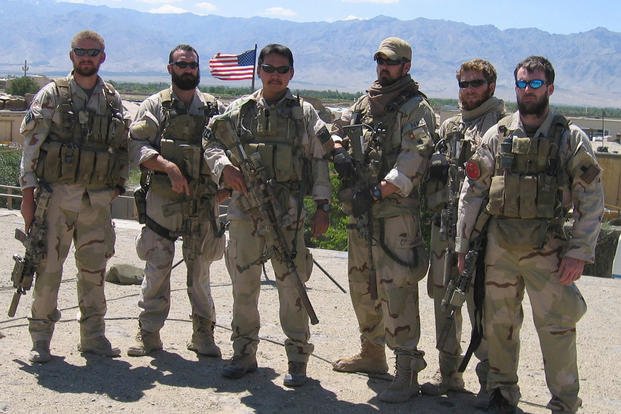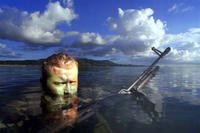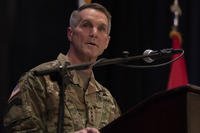Flying with the United States Army's 160th SOAR (A), Special Operations Aviation Regiment, the "Nightstalkers," were some of the most exhilarating years of my professional Army career.
These are the men and women who, when the president asks in hushed tones if our nation has the capability to fly specially adapted helicopters into the darkest corners of the globe, raise their hands and volunteer for missions no one else will try.
Related:
A few years ago, I was a pilot and platoon leader in a Nightstalker helicopter unit in Bagram, Afghanistan, meaning I was legally and morally responsible for the safeguarding and employment of four aircraft and about 30 specially trained soldiers. We normally fly exclusively at night, using night vision goggles to maintain the element of surprise, and on this particular night, we'd been asked to insert a group of four U.S. Navy SEALS deep into enemy-held territory to collect valuable intelligence on a powerful militia leader in the Korangal Valley.
My immediate supervisor, the commanding officer of our helicopter task force, was Maj. Stephen Reich, a West Point baseball standout and experienced Nightstalker. He'd been drafted to play for the Baltimore Orioles organization but instead elected to serve his country while his peers went on to more lucrative careers in baseball and the sports entertainment industry.
Maj. Reich was a driven leader and pilot, just like when he played ball. He expected those around him to run fast, take chances and always look for an edge against the competition. He'd once looked at our standard Army-issued helicopter checklist, for example, and read the line:
"When in doubt, take the most conservative route or action."
"Cross that line out, Brady," he would tell me.
Heresy in the world of military aviation, but in his mind, we were hired to serve in America's premier helicopter force because of our professional judgment, not our ability to read a checklist.
On this night, Codenamed Operation Red Wings, we looked for every edge we could find. From landing zone selection to reconnaissance and firepower requests, we wanted to give Michael Murphy, Marcus Luttrell, Danny Dietz and Matt Axelson every advantage possible.
We waited for the sun to set, and under the cover of a moonless night, my crew and I flew the four SEALs deep into the Hindu Kush mountains.
After "roping" them into their insertion point, we flew to Jalalabad where I coordinated with SEAL commander Erik Kristensen on tomorrow's mission objectives as we both listened to "Murph" whisper his team's progress over the radio.
Once Murph and the team found a place to hide, we "buttoned up" the helicopters and tried to get some rest in preparation for the next night's missions. Everything seemed to be going according to plan. Until ...
"Sir ... sir, wake up. Murph and the team were compromised; they need immediate support."
I was prodded awake by my maintenance officer, and the look on his face told me more than his words. This was bad. The team had been discovered by some goat herders, who, in turn, revealed their position to the reconnaissance target individual and his militia. They were in a major ambush and were fighting for their lives.
I ran over to my platoon sergeant, Sgt. First Class Michael Russell, who was also asleep, and asked him to prep the aircraft while I found our flight lead pilot, Chief Warrant Officer 3 Corey Goodnature, to start initial planning.
I was the designated QRF, or "Quick Reaction Force" platoon leader for this mission, so it made sense that I would lead the flight. Also, one of our core promises to our "customers" is: "If we put you in, we'll take you out." It seemed like only a couple of hours since I'd put them in, but by God, I was going to get them out. I felt it was my duty.
Maj. Reich, however, felt otherwise. As the rotors were turning and I was completing last-minute coordination with SEAL Commander Kristensen onboard the helicopter, Maj. Reich stepped on the aircraft and walked over to me like a major-league coach walking to the pitcher's mound.
"What's your plan, Brady?" he inquired. I briefed him on my plan, and Kristensen nodded in approval.
"I like it," he quipped, "everything except the parts that involve you. Now get off."
I was stunned. To put what just happened in perspective, that's a bit like New England Patriots QB Tom Brady under center on a crucial fourth down during the Super Bowl, reading the defense, and right before snapping the ball, Coach Bill Belichick calling timeout, running onto the field and saying, "Hey, Brady ... tell you what, how about you let me take this one? Run on over to the sideline and take a knee."
Furiously, and fruitlessly I might add, I pleaded my case to Reich. This was my mission, I reasoned. He'd trained me for this, but his mind was made up and he had his reasons. I patted Goodnature on the shoulder, jabbed Russell in the ribs and wished them all luck.
Stepping off the back of the aircraft, I felt a tremendous guilt as I watched them taxi for takeoff. I locked eyes with Russell, positioned at the back of the ramp, and we shared a look as they rolled away. And then they were gone.
If you've read the book or seen the movie "Lone Survivor," you know what happened next. Reich, along with Goodnature, Russell, Shamus Goare, Kip Jacoby, Marcus Muralles, Tre Ponder, and Chris Scherkenbach along with Navy SEALs Kristensen, Jacques Fontan, Dan Healy, Jeff Lucas, Michael McGreevy, Shane Patton, James Suh and Jeff Taylor were shot down while attempting an insertion near Marcus Luttrell and Killed In Action.
Along with Matt Axelson, Danny Dietz and Michael Murphy, we lost 19 Americans that morning and, at that point, the most special operations soldiers and sailors in a single mission since World War II. All amazing men, fathers, husbands, sons, and friends taken from us way too soon. Only Marcus Luttrell survived.
Lessons on Leadership and Duty
Through his selfless actions, Maj. Reich taught me many things that day. He taught me the most important place for a leader is at the decisive point of the battle.
The decisive point is that point in time and/or space where the stakes for your team are highest and where advantage could swing wildly between friend and foe. It's the point where the morale of your team could turn on a dime and where all of the uncertain variables of your situation congregate to foil even the best-laid plans.
The decisive point requires the presence of the leader because he can see and hear with his own eyes and ears and can make appropriate decisions in real time. If a leader is to have any influence at all, it is here.
He also taught me that real leaders never ask their teams to do things they wouldn't be willing to do themselves. This is true in business, but even more so in war.
Leaders eat last -- meaning, if you're going to run out of food and some of your troops will go hungry, you should be among the hungry. The millions of ghosts of World War I remind us in unison of the cowardly actions of officers who sent men into battle miles away from their own relative comfort and safety, only to send wave after wave to their deaths, completely unfazed by the danger.
Maj. Reich knew in his heart this would be one of the riskiest, most dangerous missions we'd flown in a long time. If he was going to ask his men to fly into the teeth of the enemy, he would be right there alongside them. He believed with every fiber of his being that he owed that much to Luttrell, Murphy, Dietz and Axelson, and those he would ask to risk everything to save them. It was the most valiant act of sacrificial leadership I have ever witnessed.
One Final Lesson
But most importantly, he taught me that these beliefs were so deeply held, that he lived by them and was willing to die for them. So his final lesson was not to waste your time living your life by principles and values you don't really believe in.
Reich's final lesson urged us all to find those beliefs that drive you, that wake you up in the middle of the night crying, that you'd be willing to go to the ends of the Earth for. Find those things you believe in so strongly, you'd give up absolutely everything to see them through.
Finally, Maj. Reich deeply believed in the Nightstalker Creed and our motto: "I serve with the memory and pride of those who have gone before me, for they loved to fight, fought to win and would rather die than quit. Night Stalkers Don't Quit." He and the men of Turbine 33 and Spartan 01 never will be forgotten. Rest in peace, brothers. Until we meet again.
NSDQ
LLTB
Matt Brady is a retired Army Special Operations Aviation officer with more than 18 years of operational, strategic and organizational leadership experience. He's a West Point graduate, holds a master's of philosophy degree in military strategy and received his MBA from Harvard Business School. He's also an executive consultant at Afterburner Inc., a veteran-owned and -operated small business dedicated to helping good companies become great by leveraging the tools and techniques of Flawless Execution. https://www.afterburner.com/
Want to Know More About the Military?
Be sure to get the latest news about the U.S. military, as well as critical info about how to join and all the benefits of service. Subscribe to Military.com and receive customized updates delivered straight to your inbox.











